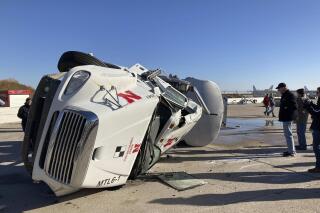Bang! Nebraska crash test could lead to safer road barriers

A 2010 Freightliner Columbia lies on its side after crashing into a concrete barrier at a University of Nebraska-Lincoln test facility on Wednesday, Dec. 8, 2021, in Lincoln, Neb. University researchers conducted the experiment with a loaded, 80,000-pound tractor-tanker to test the effectiveness of a new concrete barrier that was designed to reduce the severity of such extreme crashes. The research has piqued the interest of many U.S. states and other countries. (AP Photo/Grant Schulte)
LINCOLN, Neb. (AP) — Researchers at the University of Nebraska smashed an 80,000-pound tractor-tanker into a concrete barrier on Wednesday in a test that could lead to safer, more cost-effective barriers throughout the United States.
The truck hit the barrier at around 50 mph, screeched along the side and tilted precariously, but it didn’t roll over the top — just as researchers had hoped. Instead, the truck lurched away from the barrier, flopped onto its side and skidded into a roll before coming to a rest a few hundred feet away.
The high-speed safety experiment was part of an effort by the university’s Midwest Roadside Safety Facility to create thinner, shorter barriers that are still able to prevent tanker trucks from rolling over them. Researchers said they were still happy with the results, even though the truck flopped onto its side after bouncing away from the barrier.
“For the purposes of containment, the test was phenomenal,” said Cody Stolle, a research assistant professor at the University of Nebraska-Lincoln. “This would have prevented anybody from penetrating past that barrier into opposing traffic, off a bridge, or into anything that would have been behind it. The barrier performed exactly as it should have.”
Bob Bielenberg, a university research engineer, said the university has also worked with NASCAR officials over the years to improve their vehicle safety. He said the special barriers tested on Wednesday could help shield highway overpasses with traffic beneath them or other areas where a spill would be disastrous.
“You may have situation where you have something critical behind there,” Bielenberg said.
The experiment was designed to simulate extreme conditions, with the truck loaded to 80,000 pounds, the maximum weight allowed on interstate highways. It hit the barrier at a side-swiping, 15-degree angle to simulate the driver veering sharply out of control. The 24-year-old trailer was filled with 7,000 gallons of water in place of hazardous chemicals.
With its engine running in neutral and the driver’s cabin empty, the tractor-trailer was pulled up to the correct impact speed with two two trucks on a cable pulley system. It was heavy enough that the tow trucks’ tires squealed as started tugging. The experiment took place at an outdoor testing facility next to the Lincoln Airport.
Stolle said the crash yielded a trove of data and video footage that university engineers will study. He said several states have expressed interest in using the design once the experiment was completed, including Virginia and Utah, and some of the barriers could be put in place in the United States in as little as 12 months.
“This test was a once-in-a-lifetime opportunity,” Stolle said. “That’s why there’s such a broad interest.”
___
Follow Grant Schulte on Twitter: https://twitter.com/GrantSchulte
